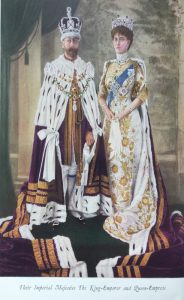
The Coronation Durbar
Delhi
December 1911THE ROYAL INTENTION TO HOLD AN IMPERIAL ASSEMBLAGE AT DELHI was declared in a Proclamation published in the Gazette Extraordinary of the 22nd March 1911:-
Whereas upon the death of our late Sovereign of happy memory King Edward, upon the sixth day of May in the year of Our Lord one thousand nine hundred and ten, We did ascend the Throne under the style and title of George the Fifth by the Grace of God, King of the United Kingdom of Great Britain and Ireland, and of the British Dominions beyond the seas, Defender of the Faith, Emperor of India; and whereas by our Royal Proclamations bearing date the nineteenth day of July and the seventh day of November in the year of Our Lord one thousand nine hundred and ten in the first year of the Reign We did publish and declare Our Royal Intention by the Favour and Blessing of Almighty God to celebrate the solemnity of Our Royal Coronation upon the twenty-second day of June one thousand nine hundred and eleven; and whereas it is Our wish and desire to make known to all Our loving subjects within Our Indian dominions that the said solemnity has so been celebrated and call to Our presence Our Governors, Lieutenant- Governors and others of Our Officers, the Princes, Chiefs and Nobles of the Native States under Our protection and representatives of all the Provinces of Our Indian Empire, We do by this Royal Proclamation declare Our Royal intention to hold at Delhi on the twelfth day of December one thousand nine hundred and eleven an Imperial Durbar for the purpose of making known the said solemnity of Our Coronation and we do hereby charge and command Our right trusted and well beloved Councillor Charles Baron Hardinge of Penshurst, Our Viceroy and Governor-General of India, to take all necessary measures in that behalf.
Given at Our Court at Buckingham Palace this twenty second day of March in the year of Our Lord one thousand nine hundred and eleven and in the first year of Our Reign.
The Coronation Durbar held in an amphitheatre close to Delhi, which was then to become the capital of India rather than Calcutta, was the greatest and most unashamed show of military strength ever staged by the British Empire. The spectacle was held between December 7th and December 16th 1911, and the new George V was the first English King to leave Europe since Richard Coeur de Lion.
The show was staged to ensure that the large number of Maharajas and other Indians appointed by the British to high office for the running of India had an opportunity to show their devotion to the Crown.
Because the Tenth (PWO) Royal Hussars had a very close relationship with the Monarchy, they had a very visible part to play in the entire duration of the event. Being stationed at Rawal Pindi on the North West Frontier from 1906, the Regiment had a substantial distance to travel to get to Delhi.
The first mention of the Durbar in the 10th Royal Hussars Gazette appeared in the July issue of 1911, when Major Pillinger, as editor, wrote:
The Delhi Coronation Durbar continues to engage a deal of our thoughts and speculation. We have not learned much, but are in all probability to march there and back, which will occupy at least four months. No date has been named for our departure; our most reliable vaticinators predict the 9th October. Sites have been allotted at Delhi for everyone – soldiers, officials and civilians. Our Brigade, which includes the 14th Hussars, two Native Cavalry Regiments, and two Horse Batteries, will be in camp on the right of the Grand Trunk Road to Balswa. It is about three and a half miles from the Delhi Central Station, whence a broad-gauge railway has been constructed, with some intermediate stations, and the Terminus – The Cavalry Camp Station. The camp abuts onto the Review Ground, and is about four miles distant from The Royal Camp. The area of the Coronation Camp is about 24 square miles.
As with all plans, they have a habit of being changed, and in the October issue of the Regimental Gazette of 1911, Major Pillinger wrote the following:
The result of the drought which affects us most is the change in our orders for the journey to the Coronation Durbar. Originally we were to have left here by march route next Saturday, 7th October, and arrive at Delhi on the 25th November. Then we were to have taken part in the manoeuvres prior to the Coronation parades and ceremonies, and on their termination, march back to Pindi. But man’s proposals were again circumvented, and we now travel both ways by the prosaic but speedy railway train.
It is now directed that we travel in three trains, the first is scheduled to leave Rawal Pindi at 11-02pm on the 22nd November and arrive at Delhi at 4.30am on the 24th; the second to leave at 9.40am on the 23rd and arrive at Delhi at 1.15pm 24th; the third to leave at 11.44am on the 23rd and reach its destination at 5.28pm on the 24th.
A Madras paper announces that “Sir Arthur and Lady Lawley will attend the Durbar as guests of His Majesty the King”. We anticipate with the keenest pleasure meeting Sir Arthur after several years in which he has done so much for the Empire.
Amongst other old Tenths who are expected to visit us at Delhi are Sir William and Lady Noreen Bass. As in the case of many other friends of the Regiment, they may rely on a warm welcome.
From the 100,000 troops which it was originally proposed should attend the Durbar, the estimated strength has now sunk to 51,500, which includes three divisions of regular troops with three cavalry brigades, 1,000 volunteers and 7,000 Imperial service troops. The Pioneer understands “that the Grand Parade, on the 14th December, will occupy about two and a half hours”.
Major Pillinger attended the Durbar in its entirety and was awarded a Coronation Durbar Medal
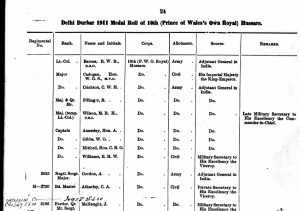
As recorded on page 24 of the Delhi Durbar Medal Roll.
In the Regimental Gazette dated January 1912 Major Pillinger then goes on to write a very detailed picture of the event. In his pre-amble he assures the readers that he will keep the account brief, but clearly got enthused by the memory and his recollections ran to 8,338 words, much, it has to be said, to our benefit.
His view of the Ceremony and days surrounding it was from a totally loyal soldier of the Empire, who had served the Crown for thirty five years, his whole working life, fought in two conflicts and was totally dedicated to his Regiment. His account reflects this very clearly. In the January 1912 issue Major Pillinger proudly wrote the following text to sum up the Regiment’s part in the Coronation Durbar:
It is observed that most of our correspondence avoid any description of the pageantry of the Durbar, and the Editor proposes to follow their example. It was too overwhelmingly gorgeous, too abundantly and bewilderingly spectacular for one’s powers of receptivity to paint by mere words. It was a continuous panorama of Oriental splendour and movement that sent spectators away with just a consciousness of having witnessed scenes indescribable that crowded each other out of one’s impressions.
The one thing that might have enhanced the pageant as a spectacle was an elephant procession, but as far as military display is concerned, nothing like it will ever be seen again in all probability. India can produce a diversity of armed men that astounds, and from the mere barbarian Nubian eunuch cavalry of Hyderabad, to the last word in British cavalry, there is a gamut of colour and uniform that beggars all description. Horse and foot, dragoons and artillery, mountain batteries and camel corps, scouts of irregular horses, Royal Marines and blue jackets, it was a collection of which we shall never see the like again.
_______________________
So, confining our notes to the participation of the Regiment in the Durbar, we give, briefly, the events as they happened.
On our arrival in our camp near the village of Balswa, near the Grand Trunk Road, some six and-a-half miles from Delhi, we found that everything possible had been done by Sergeant Keats and the advance party; before leaving Rawal Pindi many telegrams had been received, reporting torrential rains and the submersion of the camp.
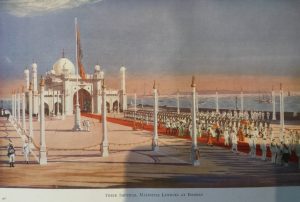
Luckily, when the first detachment appeared on the scene, no rain had fallen for three days, but traces of the effects of the bad weather which had prevailed were evident, and we felt sorry for the party, whose work had been undone. But we all settled down very quickly, leaving the horses in temporary lines near Balswa village until the ground in the camp had attained firm conditions.
The village had been vacated for some months previously by order of the Durbar authorities, every one of the villagers having been compensated by money grants for his dislodgement.
As soon as we were settled down we were engaged in Brigade drills, under the I.G.C. General Rimmington, and our time was fairly filled up thereby and by the frequent visits of the Commander-in-Chief, the Quarter-Master –General, and other officers on inspection intent.
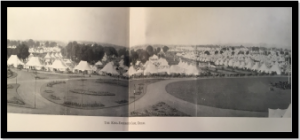
MRS WATKINS WILLIAMS was the first of the guests to arrive, soon following in her train were:
Lady Helen Mitford Sir William and Lady Noreen Bass
Lady Brocklehurst The Hon. Lilah Wingfield
Mrs Herbert Smith Miss Sylvia Brooke
Miss Fielden Mrs Stokes
Miss Hayes Capt. and Mrs Gibbs, 7th Hussars
All of whom were installed in their tents by the last day of November.
Major Cadogan left us on the 4th December, having been claimed for service by the Royal Corp.
Capt. Kearsey joined us from Rawal Pindi, on the 6th December.
THEIR MAJESTIES The King and Queen arrived and made a state entry on the 7th December. The royal train travelled to the fort station of Selimgarh , where Their Majesties alighted, and after according a reception to Indian nobles, went in stately procession, through the fort by circuitous route, to the Royal Camp. The Regiment was employed in lining the streets, Capts. Annesley and Neilson doing duty as marshals. His Majesty, in the uniform of a Field Marshall, mounted on a black charger, and the Queen Empress in a state carriage, drawn by six handsomely caprisoned horses, the chief figures in the most imposing procession of soldiers and statesmen, were greeted with loud and continuous cheers all along the route.
Prominent in the procession were the Earl and Countess of Shaftesbury.
The presence of the three men of the Household Cavalry, in the uniforms of their Regiments, was striking, evoking many recollections of peaceful manoeuvres and active service with them. On this day they wore the Indian pattern white helmet which appeared somewhat incongruous. No better scheme could have been devised for the entry of their Majesties.
Leaving the Delhi Gate of the fort well marshalled and moving easily forward, the procession came into the open, towards the Jamma Masjid which dominates the scene. And so down the Chandni Chowk, past the famous Ridge, —- where an address from the representatives of British India was received and replied to by His Majesty, —- to the Royal camp. Nothing could have been more effective, nothing more brilliant; it was a fitting prelude to the ceremonial series and joyous acclamation of His Majesty’s subjects, whether British or Indian, which marked the period of his stay in the new capital of Hindustan; none who were present will ever forget it.
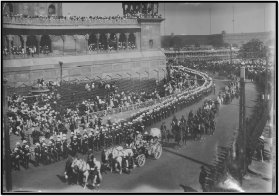 Native Prince at the State Entry Jamma Musjid
Native Prince at the State Entry Jamma Musjid
On the 8th another impressive ceremony was enacted—– the laying by His Majesty of the foundation stone to the “All India Memorial to His late Majesty, King Edward VII. “ The Tenth furnished the Royal escort, commanded by Lt-Col. Barnes which accompanied Their Majesties to and from the Royal camp.
A detachment of the Regiment under the command of Major Crichton was on duty in the gardens which have been recently formed around the site, and two Officers and three N.C. Officers and men attended as special representatives of the Regiment during the late King’s command of it. The stone placed in position by His Majesty is a block of 2 ½ ton weight bearing the following inscription:
This tablet was placed in position By His Majesty King George V
On the 8th December 1911
The memorial is a colossal equestrian statue not yet completed; it will face north, as does the tablet on which the above inscription appears. Facing east is a Tablet inscribed:
“EDWARD VII—-KING AND EMPEROR
Let this monument, erected by voluntary donations, of thousands and thousands of his subjects throughout the Indian Empire – the rich giving of their wealth, and the poor out of their poverty – bear witness to their grateful memory of his virtues and his might. He was the Father of his people, whose diverse religions and customs he preserved impartially; his voice stood for wisdom in the councils of the world; his example was inspiration to his Viceroys, his Governors, his Captains and the humblest of his subjects; his sceptre ruled over one fifth of the dwellers upon earth. His justice protected the weak, rewarded the deserving and punished the evil-doer. His mercy provided hospitals for the sick, food for the famine-stricken, water for the thirsty soil, and learning for the student. His sword was ever victorious. Soldiers of many races served in his great army, obeying his august commands. His ships made safe the highways of the oceans, and guarded his wide dominion by land and sea. He ensured amenity between the nations of the world, and gave well ordered peace to the peoples of His Empire. He upheld the honour of Princes and the rights of the defenceless. His reign was a blessing to his well beloved India, an example to the great, and an encouragement to the humble; and his name shall be handed down from father to son throughout all ages, as a mighty Emperor, a merciful ruler and a great Englishman.”
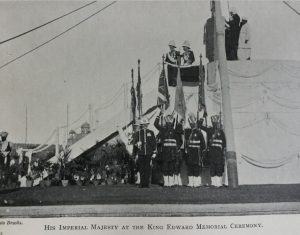
The Imperial Majesty at the King Edward Memorial Ceremony
On arrival to the entrance to the gardens, Their Majesties alighted from the state landau in which they had driven, the Royal Standard was hoisted on the Delhi Gate of the fort, and the King and Queen, attended by their suite, walked between the guards of honour into the garden, where they were conducted to their red and gilt seats beneath the shamiana. The Heralds sounded a fanfare as the procession advanced. The Governor-General then presented an address to His Majesty, requesting Him to place the foundation stone in position. His Majesty replied, and ascended to steps to where the inscribed slab was kept in position by ropes suspended from scaffolding. At this height the King Emperor was clearly visible to the crowds which filled every available spot outside the gardens – even the walls of the Jamma Masjid, distant some hundred yards, were lined with spectators – and as His Majesty put forward his hand to the stone, cheers broke out from far and near. A crowd of natives is not usually demonstrative, but on this occasion the Oriental reserve failed and a volume of sound went up that was nearly startling. The Guards of Honour saluted, the massed bands of the Tenth and other Regiments of which the King was Colonel-in-Chief, played the National Anthem, and the guns thundered from the fort. When the music died away, His Majesty descended the steps, a silver miniature of the statue was graciously accepted from the senior members of the Executive Committee, and the King Emperor and the Queen Empress drove back to their camp, guarded by Colonel Barnes escort.
On the 9th the King Emperor received various ruling Chiefs, the Queen Empress received a deputation of Indian ladies, who presented Her Majesty with a jewel. In the afternoon the game in the polo tournament between the King’s Dragoon Guards and Bhopal was in progress on the western ground when Their Majesties arrived in a carriage and four, the full emblem of state being used. These were the gold umbrella, the surajmukhi, or heart-shaped richly embroidered fan, the merchalms, and chowries. As the carriage drove into the enclosure, these were quickly recognised by the crowd. Just then there was an interval in the game, and the ground was free from players.
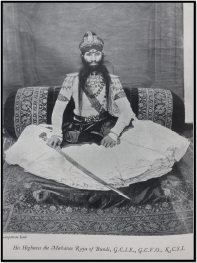
The crowd streamed across in hundreds, British and native, running hard to reach the central pavilion, so as to be in time to greet Their Majesties. This was no rehearsed effect; the heartiest of cheering, the clapping of hands, and other manifestations marked the joy Their Majesties arrival caused. The spectators who were on the side of the mound left their seats en masse, and the cheering was renewed, an enthusiastic reception being thus given by every class present. The Royal party proceeded to watch the game between the Inneskilling Dragoons and Kishengarh, and their appearance on the eastern mound drew forth more cheers.
The King Emperor afterwards walked across the polo ground to see the final of the football tournament, and there he received an ovation from the hundreds of British and Indian soldiers who were watching the game.
Their Majesties had tea in the pavilion, and left for their camp amidst another outburst of cheering which was taken up along the route, and given the greater volume by the soldiers who were leaving the football ground.
This enthusiastic reception was the feature of the afternoon; the vast crowds which thronged the road about the polo ground hurried on their way to see the Royal carriage. They know the state umbrella and the surajmukhi as emblems of sovereignty, and impulsively they rush to gaze upon their Badshah and his Gracious Consort.
The tumultuous cheering indicated the height of popular enthusiasm on this, the third day, of the progress through Delhi.
At night there was a “tattoo” by the massed bands, and fireworks.
______________________________
_
On the 10th, Sunday, Divine Service, at which all the troops were present, was attended by Their Majesties and Staff. It was held in the island of Jagatpur, in the army camp. The Bishop of Madras preached the sermon, taking his text from Revelation 11 v15.
______________________________
The morning of the 11th was occupied by His Majesty presenting colours to:
The 1st Bn. Northumberland Fusiliers
The 1st Bn. Durham Light Infantry
2nd Bn. Black Watch
1st Bn. Seaforth Highlanders
2nd Bn. Gordon Highlanders
1st Bn. L.I.
1st Bn. Connaught Rangers
18th (Native) Infantry
90th Punjabis
102nd K. E. O. Grenadiers
The King, in the uniform of Field Marshal, with a standard bearer, rode, attended by the Governor-General, the Commander-in-Chief, and the Royal Staff, and was heartily cheered by the spectators. Amongst the staff, the Duke of Teck was a noticeable figure, in the glittering helmet and cuirass of the Lifeguards.
The ceremony, when only one Regiment is presented with new colours, is one that always leaves a deep impression, but today, with seven battalions drawn up, it was more than ever a sight to be remembered.
The King, having dismounted with the Governor-General and Commander-in-Chief in attendance, stood slightly in advance of his staff during the ceremony. The colours were unfurled and towards them, in solemn procession marched the clergy of the Church of England, Presbyterian and Roman Catholic Churches, to carry out the consecration. The first of the services, that of the Church of England, was conducted by the Bishop of Lahore, the words of consecration being listened to intently – “In the name of the Father, and of the Son and of the Holy Ghost, we do dedicate and set apart these colours, that they may be a sign of our duty towards our King and Country in the site of God”
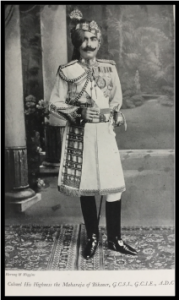 The Rev. Mr Chree, with Chaplains robed in black, conducted the Presbyterian ceremony, and Father Gentilli, a venerable figure wearing a mitre, attended by two Chaplains dressed in purple, performed the Roman Catholic service, in Latin, including the sprinkling of colours with holy water.
The Rev. Mr Chree, with Chaplains robed in black, conducted the Presbyterian ceremony, and Father Gentilli, a venerable figure wearing a mitre, attended by two Chaplains dressed in purple, performed the Roman Catholic service, in Latin, including the sprinkling of colours with holy water.
Each party of clergymen, on conclusion of their respective services, walked in procession and took up position behind the King Emperor.
Now ensued a quick movement of the Commanding Officers of Battalions, each with their senior Majors and two senior Subalterns, marched briskly with sword at “the carry” to the new colours. The colour parties advanced in slow time, the massed bands playing, and halted in turn in front of His Majesty. The customary procedure of presenting the King’s colour and the Regimental colour to the King Emperor was then gone through, and His Majesty handed them respectively to the Subalterns, who received them kneeling on the right knee.
The colour parties then returned to the drums, a triangle of which stood in the open, the apex facing the Royal Standard over Their Majesties. The seven Commanding Officers moved forward in slow time, towards the King Emperor. The new colours were unfurled and the massed drummers beat a roll. Each Commanding Officer then received an address from His Imperial Majesty, marched slowly back and formed up in rear of the triangle of drums. Another roll from the drums, followed by the band playing the “British Grenadiers”. The colour parties marched back to their battalions which presented arms, the old colours, still flying bravely, disappeared in the rear, and were closed to the strains of “Auld Lang Syne”.
The band struck up the National Anthem, and as the King mounted his charger, to proceed to the polo ground, the troops gave three cheers, and presented arms, remaining at the “present” until Their Majesties had passed to Princes Road.
On the Eastern polo ground the 18th (Native) Infantry, the 90th Punjabis, and a detachment of the 102nd Grenadiers were drawn up in a hollow square. The ground was held by Indian troops, keeping at a distance the great crowds gathered.
The King Emperor dismounted and the Queen Empress watched the parade from her carriage. Again were to be seen the drums covered with the new colours. The two senior Majors had with them two Jemadars, and these were the colour parties. The Jemadars filled the roll of the Subalterns of the British battalions, and received respectively the King’s colour and regimental colour. His Majesty the King Emperor made addresses, there were a roll of drums, a playing of the British Grenadiers march and “Auld Lang Syne”, and the ceremony closed with loud and prolonged cheers.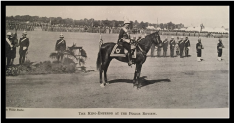
Then followed an effecting scene for the veterans, British and Native were drawn up, and the King with his staff passed down the line exchanging kindly words and halting repeatedly, as the old heroes were presented to him. Most were grey –beards, many were bowed with age, but some still bore themselves erect. The Queen Empress called one to Her carriage, and as he uncovered, and stood bare-headed in the sun, she ordered him to remain covered in Her presence. All appeared deeply affected, and it was touching to see the aged Indian veterans salaaming to Her Imperial Majesty. The Royal party returned to their camp about noon.
In the afternoon Their Majesties attended the final of the polo tournament, and again the wildest enthusiasm was displayed on arrival and departure. When the Queen Empress presented the cup to the winning team of the Inneskilling Dragoons loud cheers were given by the immense crowd who had gathered to see the game. Their Majesties listened for some time to the excellent selections played by the massed bands.
_____________________________________
On the 12th the event, the actual Coronation Durbar took place, adding another lustrous page to the history of India. On this day the Tenth formed the Royal Escort, an honour shared by “N” Battery of the Royal Horse Artillery, The Body Guard, the Imperial Cadet Corps, and the 18th King George’s Lancers. This escort was reported in the Indian press as a “noble one”, as “a cavalcade that gave pomp and distinction to the journey to the Amphitheatre” . What can be said of this ceremonial which was witnessed by spectators who numbered hundreds of thousands? Of the troops taking part in it, 20,000 were ranged in the arena itself. On the arrival of Their Majesties at the entrance to the amphitheatre, arms were presented, colours flown and then lowered, and the cortege swung glitteringly along. Two golden umbrellas with a canopy to guard against the sun’s rays, indicated to loyal eyes the King Emperor and his escort passing to the scene the most memorable in this historic period.
In the immediate vicinity of the Durbar area enormous crowds had gathered on or about the open spaces, and on the slopes of the roads. They seemed mostly villagers, each with his bundle and his stick, but mixed with them were obviously residence of the city. They were constantly on the move but clung to the route on which the presence of the troops indicated the Royal procession must pass.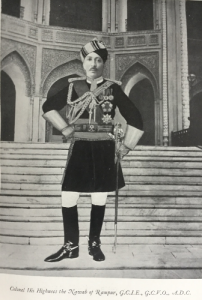
It would be impossible to estimate the numbers pouring in from an early hour, but certain it is that the count would have to be made in hundreds of thousands. Within the arena, two amphitheatres faces each other, the simplicity of the smaller, with its white colouring and minarets tipped with gilded points, being especially effective in the bright sunlight. It gleamed and glistened over the plain, and its semi-circular curve swept beautifully where the broad red roads and lawn meet in front. In it were some twelve thousand persons, on seats arranged so they rose gradually to the last tier, where perforated screens guarded the purdenashin ladies who had come to view the Durbar. Any attempt to describe the picture here would be futile. Looking upwards was a mass of colour made up of ladies’ hats and dresses, Officers’ uniforms, and turbans of natives of many colours, all mingling in a manner confusing to the eye. The lower and central tiers were ablaze with the brilliance of jewels, and splendid robes worn by the Chiefs, grouped in readiness to do homage to their Sovereign. Diamonds, rubies, emeralds and every other precious stone sparked with each movement of their wearers: cloth of gold embroideries on stuffs of every shade – purple and scarlet, rose pink, light blue and green, delicate orange, flame-like yellow, or vivid crimson – all made a picture unsurpassed for richness. The ransom, not of one, but of many kings gleamed before us. The wealth of India was here as it never was before.
But there was a great amphitheatre to astonish and to impress us. It was that of the people in the mass not of the rulers and chiefs. Of vast extent, stretched in one grand sweep, it seemed part of a great circle. It shut out all view of the outer world, for the mound was of a height to dwarf all surroundings. Built to hold 50,000 persons, not a foot of space was left without its occupant sitting or standing. The general view gave thousands upon thousands of snow-white turbans, with dark shades beneath, but there were parterres of colours which gave scenic effect that was singularly beautiful. These parterres were formed by the head-dresses of school children and students who were placed together in sections of the amphitheatre; in one section were pagris of yellow and white and light green lines, in another blues and yellows and orange, in a third blue, light green and white. Then came a gap where the road broke the semi-circle, and then came a section of green, blue and white. Further to the right was a splendid parterre of yellow in solitary beauty.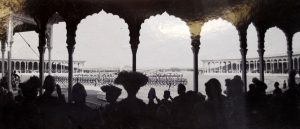
The numbers thus shut in the view were in their numbers effectingly impressive, but other impressions had to be received, for arrayed within the area were 20,000 troops, so arranged as to offer a spectacle imposing and impressive. Looking down from the first amphitheatre, we saw on our left the Imperial Service Troops, in dark blue, with red and gold turbans, then the bright red Zouave dress of a Baluchi Regiment, followed by the scarlet of the British line, the distinctive dress of the Highlanders, the green of the Rifles and Ghurkhas, and so on, in ever varying contrast, with thousands of white helmets and parti-coloured pagris stretching away in the section. To the left rear were the lance pennons of cavalry who had dismounted, which fluttered in the light breeze, which added to the general effect. The whole made up a perfect military display which never tired the beholder. The massed bands played and the coming of Their Majesties was awaited contentedly. In the centre of the enclosed space stood the Royal Pavilion, with its two thrones raised high so that all could see them. The gilded roof shone our resplendent in the sun. Nearer to the first amphitheatre was the Durbar shamiana, a study in crimson and gold, with its gilded poles, its rich canopy over the thrones standing on a dais covered with a cloth of gold, while on the lower platforms were beautiful gold and white carpets. The shamiana, with its scalloped edges, its embroidered and golden tassels, was worthy of the place assigned to it, — in full and near view of the subjects and feudatories of the King Emperor. Waiting, well content in the amphitheatre, gazing on the wonderful sight, suddenly the music played by the massed bands is changed. We are now listening to “see the Conquering Heroes Come” and to the sound of loud cheers. We soon know why, for to our right we see the veterans being conducted to the places reserved for them. They, who had stood in solid serried ranks to meet the storm of war, now marched in irregular formation, and many with uncertain steps, but their brave hearts still beat in their breasts. The cheering rose higher, and yet higher as these veterans passed to their places, the bands playing “Auld Lang Syne” whilst they marched slowly on.
Shortly after 11.30 the Governor-General and Lady Hardinge arrived, and amid cheers, took their places on the platform of the Durbar shamiana, on the right of the thrones, where a group of Indian pages beautifully attired, had already gathered. Two were in attendance of the Governor-General, and one acted as a page to Lady Hardinge.
A few minutes before noon the first gun of the salute of 101 was fired, indicating Their Majesties had reached the entrance to the amphitheatre, and the escort filed rapidly off, to make way for the Royal carriage which soon appeared in full state, and drew up at the shamiana. Its way had been heralded by loud cheers, which continued as all rose in a spontaneous burst of loyal feeling, and the Royal Standard flew out from its high mast. The Guard of Honour saluted and the massed bands played the National Anthem.
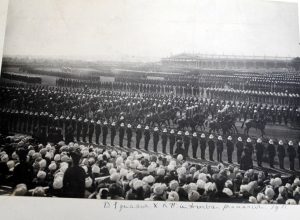
The Processional Entrance of the Tenth Royal Hussars
The King Emperor wore an Imperial crown of a band of diamonds 1 ¾ inches wide, studded with four large emeralds, and four large sapphires. Above this were four crosses with ruby centres, alternating with four fleur de lys with emerald centres. From these sprang four diamond arches, supporting the orbe, on which was a Maltese cross in diamonds, with a large emerald in the centre. The cap was of purple velvet turned up with ermine. His Imperial Majesty’s robe was of Imperial purple with the surcoat of purple. He wore white satin breeches and silk stockings. He wore the collars of the Star and Garter of India, also the Star of Order of the State of India.
The Queen Empress’ was of white satin with an embroidered design in gold of rose, shamrock and thistle, and the border of lotus. The Star of India was embroidered in the front. Her robe was of purple velvet, trimmed with ermine border and gold braid. The orders worn were the Garter and Crown of India. Her Imperial Majesty had on a magnificent diadem of diamonds and emeralds, with brooch and necklace to match.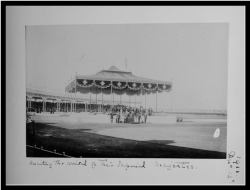
Their Imperial Majesties alighted and proceeded hand-in-hand to the thrones in the shamiana, Indian pages bearing their trains. In attendance of Their Majesties were many Ruling Chiefs and Pages of Ruling Houses. Several of these pages were quite little boys, looking charming in their light dresses shining with gold. Their Majesties, having taken their seats, were facing the crowded amphitheatre with its twelve thousand occupants, for the hour had not yet come when they would turn to the greater gathering, farther removed from the presence. For the first time in history the King of England and his Consort appeared in all the glory attached to the persons as Emperor and Empress of India, and it was a solemn and impressive moment. Its reality came with a force and swiftness that obliterated all feelings except of reverence and affection, and all rejoiced that at last the great ceremony of all was on the eve of accomplishment. The guns were still thundering forth their message, and when the last echo died out, Sir Henry McMahon Master of the Ceremonies, advanced forwards and obtained the King Emperor’s command to open the Durbar.
A flourish of trumpets and a roll of drums followed, and then His Imperial Majesty delivered his speech, punctuated by frequent bursts of applause.
Then began the ceremony of doing homage, the Governor-General advancing and kissing his Sovereign’s hand, followed by the Commander-in-Chief, members of the Executive Council, the Ruling Chiefs, Agents to the Governor-General, Residents, Judges of the High Courts etc.
The Begum of Bhopal was loudly cheered, and applause broke out frequently as this or that Chief bent low in reverence to their Imperial Majesties.
The Sawbwas of Kengtung and Yawnghwe in their strange and picturesque dresses of gold, with pagoda hats were gazed upon with admiration.
The Jam of Nawanagar, familiarly known as “Ranji” was recognised by many and met with a hearty round of applause.
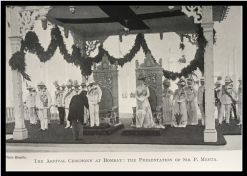
The Arrival Ceremony at BomBay: The Presentation of Sir P. Mehta
This ceremony over, Their Imperial Majesties rose and descended from the thrones. The high-born pages ranged themselves behind and raised the lengthy trains. Their Majesties turned outwards, the King Emperor to his right, the Queen Empress to her left, and descended from the throne dais, meeting at the northward side. The whole multitude rose to their feet as Their Majesties left the throne and remained standing during the slow course of the procession. Preceded by the Lord High Steward and the Lord Chamberlain to the Queen Empress who were carrying wands, and stepping backwards, the Emperor and Empress of India paced along the marble causeway. The crown and the diadem glittered in the sunlight, despite the scarlet and gold chatras held over Their Majesties’ heads.
Only the pages, the chatras bearers, and the native attendants with the royal emblems were near the Imperial couple in this most stately progress. So they reached the Royal Pavilion and ascended the steps to the lofty Thrones beneath the great flaming dome of gold. Their backs were now turned upon the great Durbar amphitheatre, and they faced the great semi-circular mound of public audience where the people of India were gathered in their hosts. On these exalted thrones the Emperor and Empress were clearly visible above the helmets and turbans of the troops, to all the gaily clad multitude on the mound, whose cheers and clapping amply testified their delight at this splendid, almost awe-inspiring sight. There was a pause while Their Majesties showed themselves, in their supreme imperial splendour to the crowded populace. Then with a stirring roll of drums went forth a summons to the Heralds, and from a gap cleft between the two wings of the mound opposite the Royal Pavilion, the Delhi Herald, General Payton, with the Assistant Herald on his left, rode into the arena, followed by his twenty- four trumpeters. The Heralds wore tabards emblazoned with the Royal Arms, and the trumpeters were attired in surcoats of maroon velvet, almost entirely covered with cloth of gold. On the banner hung from each trumpet were the Royal Arms. At the entrance to the Circular Road another flourish was sounded, and separating at the flagstaff, the Herald turned to the right, The assistant Herald, Malik Umar Hayat Khan, to the left, each followed by twelve trumpeters. At a slow canter they passed in front of the troops up to the front of the Durbar amphitheatre, wheeled inwards, and returned, one section on each side of the causeway until they came in front of the pavilion, where they drew up and halted in front of the thrones. There they sounded a third flourish.
Then the Heralds, by command, read the Proclamation, which was the essential feature of the Durbar.
Both Heralds faced the peoples’ mound. General Peyton first read the Proclamation in English, then Malik Umar Hayat Khan repeated it in Urdu. When this had been done, the trumpets spoke again, and a bugle gave its warning note. Twenty thousand rifles were brought to the present, and the massed bands played “God Save the King” from outside the arena, near the Heralds’ Entrance, six guns boomed forth together, a few seconds and six more from the right, and six from the left, until the salvo of 101 guns had been fired. The troops outside fired a feu de joie, the sound of which vanished speedily in the distance but in a very short time returned to the Amphitheatre. Each time it came back the bands played a verse of the National Anthem. The salute ended, Lord Hardinge read the statement of the boons which it had pleased the King Emperor, after consultation with his Ministers and the Governor-General in Council to grant to his Indian subjects.
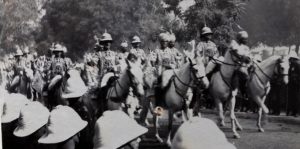
Mounted Ensigns
After this the Master of Ceremonies obtained leave to close the Durbar. Again the bands played the National Anthem, and all present in the Amphitheatre joined in singing it. The Escort and royal carriage entered the arena, and Their Imperial Majesties departed, leaving all bewildered by the greatness of a ceremony of which only the faintest of impressions can be conveyed by these notes. Expectations of a fine spectacle at the Durbar had been universal, but the most imaginative never conceived such a wonderful day as this, Every detail of this epoch-making day, the glowing colours on the packed mound, the troops, the multitude of Indians of every caste, the shamiana and the pavilion, and on the thrones the two Royal figures, gave meaning and inspiration to all this pomp and dignity.
_____________________________________________
Some idea of the profound impression made by the Durbar on the native mind may be gathered by the scene that took place immediately Their Majesties had left the arena. The vast crowds left the spectators’ mounds and surged up to the steps of the Royal Pavilion, salaaming low before the two thrones, transported by fervour that partook of religious ecstasy, induced by having been in the presence of their Emperor and seen him in his Imperial glory. Respect had restrained them while the Emperor and Empress remained, but as soon as their presence was removed, enthusiasm became too great to be restrained, and they hastened to make obeisance at the spot where the representative, in their eyes, of the Almighty on earth had appeared before them in His Majesty.
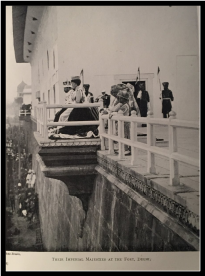
There Imperial Majesties at the Fort Delei
On the morning of the 13th the King Emperor received the officers of the volunteer contingent on duty at the Durbar, and presented medals to the gallant seven of the Ordinance Department who saved the Arsenal at Ferozepur. Then the officers of the three Body-Guards were presented, all the Indian officers presenting the hilts of their swords to His Majesty, emblematic of their fidelity and devotion. The officers of the cavalry regiments next advanced in groups of four, followed by other arms, including the Imperial Service Troops.
In the afternoon the Garden Party and People’s Fete was attended by innumerable European and native guests. The scene of the Garden Party was within the walls of the fort; “And oh; if there be an Elysium on earth, it is this, it is this.”
So sang the Persian poet of old, and Shah Jahan the Magnificent when he built the exquisite of private audience in the Delhi Fort, engraved the words on the walls in letters of gold. They came back with irresistible force to the throng of British and Indian guests strolling beneath the trees in the lovely gardens. With fountains playing all round, with the marble halls, and pillars of the palace as a background of the scene, Bands discoursed sweet music from various corners of the lawns, and it was acknowledged that here at last was the perfect garden party. But it was much more than this. It was the fitting compliment to yesterday’s Durbar. There was no comparison between the two occasions in importance and for sentimental effect, they were so different in character. But certainly the Garden Party was the artistic finishing touch to the Durbar, and if any note was wanting, supplied it. At the Durbar we saw the Emperor in Might and Majesty, in splendour and power, proclaiming his authority and announcing in person his Royal will. Today we kept high revel in no less splendour. He was the great Moghal. In the surpassingly exquisite hall of his predecessors he showed himself to his guests, and from the Musammam Burj he exhibited himself to the people, exactly as his predecessors were accustomed to do centuries ago.
In these walls and on these lawns, nearly three hundred years ago, Shah Jahan walked, perhaps with his lovely Mumtaz Mahal, while Aurangzeb with his three brothers, whom he subsequently defeated and killed in bitter rivalry, may be playing as children round the Nahr-i-Bihist, the stream of Paradise, in the garden. Round this court, in those days, gathered chivalrous Rajputs, adventurous Pathans, stalwart warriors of Hindustan. Occasionally a wandering Englishman was hospitably received and gazed in wonder on the fairy halls, never dreaming that one day the descendant of his king would stand as Emperor with the peacock throne glittering.
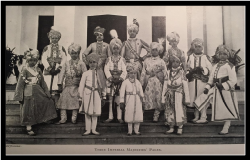
The Imperial Majesties Pages
Today the scene was revived with splendour that was even greater. The peacock throne has vanished, but the owner of the Koh-i-Nur was there. To compensate for the loss of jewels was a gathering of all races, such as Shah Jahan could never gather together. Never before have Chieftains from Bhutan and Sikkim, Ghurkhas from Nepal, Tamils and Telegus from the south which the Moguls never could subdue, mingled at Delhi in the Emperor’s presence with Rajputs and Muslims. Mahrattas, it is true, used at times to make salaams, but with suspicion and enmity in their hearts. Today their Princes and officers were there, yielding to none in loyalty and devotion – for when has an Emperor ever had a more loyal feudatory than the present Scindia, or than Kolhapur, the direct heir of Sivaji, to take but two names from all the Mahrattas gathered at Delhi?
Below the fort walls, by the Bela, by the Jumna’s banks, was assembled a vaste concourse of the humbler millions of India. Since the first dawn of the day the different communities had made processions and offered up prayers for the long life and prosperous reign of the Emperor and Empress and now they were enjoying the gaiety and amusements of the Badshahi Mela , the wrestling matches, the circus riders of Patiala and Rampur, the sham attack upon the Fort by the Gwalior troops, the fire balloons and wondrous kites and the daylight fireworks that burst in puffs of smoke and silver streaks, whistling shrilly as they fell through the air. But above all things the huge crowd hoped to witness the Darshan, the gracious appearance of the Badshah at the Musammam Burj, on the octagonal tower with the fretted balcony of marble, at which, in olden times, the Badshah used daily to show himself to the people.
Their Majesties arrived at 3.30pm and moved freely about the garden amongst their guests. They visited the loan exhibition in the museum in the palace building known as the Mumtaz Mahal. After spending some time there, Their Imperial Majesties retired and donned their Imperial Crown and Robes. Then they entered the lovely marble balcony of the Musammam Burj, and granted the Darshan, or appearance, before the people assembled on the Zer Jharokha below. But the fretted sides of the balcony did not permit of a sufficiently expansive view, and after a few minutes Their Majesties quitted the Burj, and passed to the open platform between the two buildings from which the Burj projects, and the Rang Mahal. From this another balcony projects from the line of the Fort walls, Over the Zer Jharokha. On this had been placed the solid silver thrones, covered with gilding, and upholstered in crimson velvet. There Their Majesties took their seats, the staff retired, and only the princely Indian pages remained in attendance. At first the pages stood behind the thrones, but the King Emperor feared they would blur the spectacle for those below, and he made the pages stand on either side, afterwards bidding them seat themselves behind him. Thus the two crowned and robed figures were left in isolation for the people to feast their eye upon.

The sight was impressive and can be well imagined, and below the dense crowds advanced in two parallel columns, banners being held aloft proclaiming from what district of tashil each group hailed. Each sect was distinguished by the colour of its pagris, and blocks of colour passed in procession. From the whole mass arose a roar of cheering, such as never before has been heard in any Indian assemblage. The Durbar itself provided no more magnificent spectacle, the Emperor and Empress on the walls above, the moving volume of people below, and the enthusiasm seemed to reach its climax. For nearly three quarters of an hour heir Majesties sat there, a sight which no one there can ever hope to see surpassed. It was truly magnificent.
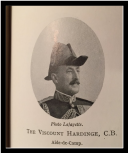
The Vicount Hardinge, C.B.
Presently, Their Majesties left the thrones, and returned to the Dewan-i-Khas The sun set and illuminations and fireworks brought to a close a ceremony in which was omitted no point that could lend splendour, and no detail that could add to its effect, thus completing what was begun at the Durbar.
————————————————–
On the 14th was held a review of troops greater in number than have ever gathered for a parade in India before, nearly forty thousand fighting men having passed before the King Emperor, in all the pomp and circumstance of military display. The last public ceremony, save that of the State departure which marked the Durbar period, it was magnificent. Every important race, from which the army in India is recruited, was on the parade, and there were Regiments whose splendid record of service is written in the history of the wars in which they have played their part.
The stands to the right and left of the Imperial box were crowded with spectators.
The armed strength of India was disclosed only in part, for it would have been possible to have double or even triple as many men assembled before the King Emperor, and yet to leave garrisons sufficient for the normal duties of peacetime. If the original plan had been followed, a hundred thousand troops would have faced the saluting flag today, but there were enough to make this review a memorable one, the first in India in the presence of the Sovereign. Punctually at ten o’clock Their Majesties arrived on the ground, the King riding his black charger, and wearing his Field Marshal’s uniform. The Queen Empress was in a carriage, with the Imperial Cadets as escort. A Life Guardsman acted as Standard bearer to His Majesty.
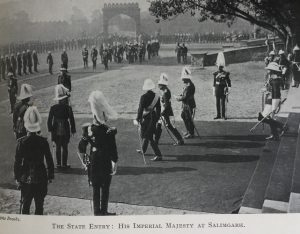
The State Entry: His Imperial Majesty at Salimgarh
A salute of 101 guns was fired as the procession advanced, and the Royal Standard was hoisted on the flagstaff, the guards of honour of blue-jackets and Royal Marines joined in the salute that was given. The King Emperor, attended by the Governor-General, the Duke of Teck, and two equerries, rode out to meet the Commander-in-Chief, and made a formal inspection of the troops. The cavalcade, formed of three combined staffs, was a brilliant one, and following it was the carriage of the Queen Empress, who thus passed closely in front of the troops. The inspection completed. Their Majesties returned to the flagstaff, to the accompaniment of loud cheering from the stands.
By this time the troops had begun to take up their positions and the march past began.
Frequent bursts of applause from the spectators accompanied the passing of Regiments or Batteries which won admiration by their bearing or smartness.
The Imperial troops were led past by their chiefs, Scindia, Bikanir, Patiala, and others who were recognised were loudly cheered, but the most enthusiastic applause went to the young Chiefs of Jodhpur, Bhawalpur and Bharatpur. Jodhpur, still in his teens, was mounted on a white charger and wore a gold uniform; Bharatpur rode a pony whose saddle-cloth and trappings were golden; Bhawalpur, a tiny boy, lead his camel-corp. riding his camel with saddle-cloth of scarlet and gold, and as he saluted the King Emperor with his diminutive sword, the cheers of the spectators on the stands were loud and long.
The gallop past of the Cavalry and artillery was more exciting than was usual at reviews, and there was none of the rather deliberate riding sometimes seen. The dash of the horse batteries was admirable, and the cavalry went by at a pace that won universal praise.
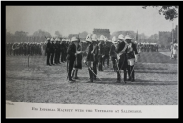
The Imperial Majesty with the Veterans at Salimgarh
The gallop past ended, the whole force advanced in review order, the infantry and camel corp. formed up in line of divisional masses, the Cavalry in column of Brigade messes, and the Royal Artillery in line. The line advanced under the Commander-in-Chief to within 150 yards of the Royal Standard, the massed bands playing the British Grenadiers”, a royal salute was given, and then three cheers for the King Emperor, followed by three more for the queen Empress. The Royal Horse Artillery galloped to a position about a thousand yards distant, and came into action, and a salute of 101 guns brought the review to a close.
In the evening and Investiture was held in the big shamiana in the royal camp, the ceremony lasting over two hours. Amongst those on whom His Majesty conferred honours were: Sir Arthur Lawley created Knight Grand Commander of the Order of the Star of India; Lieut. Col. M. R. H. Wilson, Companion of the Order of the Star of India.
—————————————————
The 15th was another busy day for Their Majesties. In the morning a ceremony which had not been contemplated when the Durbar programme was sanction, took place in the Government of India camp.
Upon the Royal announcement regarding the transfer of the capital of India to Delhi, it was suggested that Their Imperial Majesties should themselves lay the foundation stones of the new city, beyond the Ridge, and this was at once adopted.
Accordingly, at 10 o’clock this morning all things having been expeditiously prepared, Their Imperial Majesties, attended by a very small suite, arrived at the spot chosen, in the Avenue where the tents of the Executive Council were pitched, where they were received by the Governor General and the Members of the Council, who walked towards the foundation stones, on which in gilt letters were the words “15th December 1911” and at the foot of the platform all faced towards the dais, under a canopy on which two thrones, now occupied by the King Emperor and Queen Empress had been placed. H. E. The Governor General delivered an address, after reply to which His Majesty proceeded to the platform, spread the mortar with a gold trowel handed to him, The stone was lowered into its position and tapped with the mallet in the usual ceremonial way, General Peyton declared the stone “well and truly laid”, the Assistant Herald made a similar announcement in Hindustani, the trumpets sounded a fanfare, thus concluding the ceremony. Thence Their Majesties went to the polo ground and made an inspection of the Indian Police.
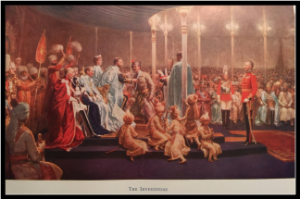
The Investiture
In the afternoon Their Majesties drove to the review ground to witness the Military Tournament, and Point-to-Point races. On the conclusion of the events His Majesty presented the prizes to the winners, Sergeant Major Burdett being the recipient of the silver medal as the second best man-at-arms of the Warrant and Non-Commissioned Officers and men of the British troops serving in India.On the morning of the 16th, the last day of this memorable period, the representative leaders of Hindus, Mahomedans, and Sikhs, headed by the Maharajah Bahadur of Dharbhanga, were presented to Their Majesties at the King’s camp.
At 11 o’clock a flourish of trumpets announced the arrival of Their Majesties at the audience shamiana in the royal camp, where had gathered the Ruling Chiefs, their political officers and sardars, who were given gold coronation medals. Their Majesties passed down the assembly, Sir Henry McMahon announcing the name of each Chief, who made the usual reverence.
The band played the National Anthem, and the procession was formed as on the occasion of the State entry. It proceeded at the trot along the troop lined route, by way of Chauburja Road and Alipur Road to the Kashmir Gate, and the Lothian Bridge to the Lahore Gate of the fort, outside which on the Champs de Mars stood troops in solid mass. Enormous crowds gathered all along the route, which was not through the heart of the city, and was much shorter than on the day of the entry. Enthusiastic plaudits broke out again and again, and in loving loyalty Delhi wished Their Imperial Majesties God speed.
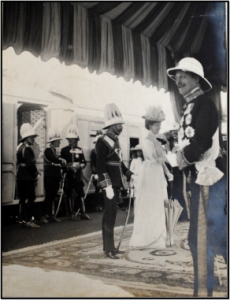
Their Majesties The King and Queen Board the Train to Leave Delhi, with Lord Hardinge in Attendance
The actual departure was from Selimgarh railway station. The platform was profusely decorated with palms and plants, and looked very gay. A treble Guard of Honour, from the Volunteer Contingent, the Durham L. I. And the 57th Wilde’s Rifles were drawn up. Their Majesties alighted from the carriage. The King Emperor inspected the guards, conversing with the officers commanding each, and then ascended to the platform. Farewells commenced, Their Majesties lingering to talk for a few minutes with officials with whom they had become acquainted during their stay in Delhi. Then His Majesty entered the train which moved off in the direction of Jumna bridge, amidst salutes from the guards of honour and the batteries on the ramparts of the fort. His Majesty stood at the door of his carriage till the train was clear of the station, smilingly acknowledging the hearty cheers which followed the train from the platform. His Majesty’s destination was Nepal.
Then the second train entered and The Queen Empress departed in the other direction, for Agra, amidst equally loud cheering.
So ended this ever memorable Royal visit to Delhi.
——————————————————
One of the salient and most pleasant features of the Durbar was the meeting of old friends of the Regiment which resulted. It delighted us to greet again the Earl and Countess of Shaftesbury, Sir Arthur and Lady Lawley and the Misses Lawley, Sir William and Lady Noreen Bass, all of whom were at one time borne on the rolls of the Regiment. We also had glimpses of “Scatters”, who, all were pleased to note, retains all his old breezy characteristics. We congratulate him upon his Durbar honour — The Order of the C.S.I.
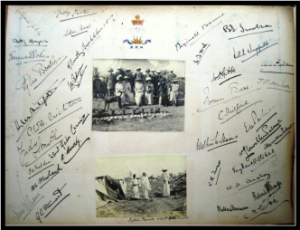
Officers and Guests of the Tenth (Prince of Wales Own) Royal Hussars
We were also pleased to renew the old and social relations with the gallant XI ( K. E. O.) Lancers, our comrades in Rawal Pindi from 1906 to 1910, with the K. D. G.s , the Inneskillings, and the 13th Hussars, with Capt. “Micky” Hodgson of the Royal Fusiliers, and many other with whom we have exchanged quip and crank in former years. That the occasion of again doing so may be granted to us early is the wish of all here.Another figure in the Royal function not to be omitted was the solitary foot-guardsman, in his bearskin headdress, who stood immobile on the steps of the Royal Pavilion throughout the ceremony on the day of the Coronation Durbar, and in rear of the dais at the Investiture.
——————————————-
Our guests commenced to leave us on the 18th, and on the 19th, 20th and 21st the Squadrons returned by train to Rawal Pindi, in the same order as that of the outward journey. The last Squadron arrived on the night of the 22nd, bivouacked at the railway station, and de-trained the horses and marched to the line on the 23rd.
——————————————-
CHRISTMAS DAY. – Our sixth in Rawal Pindi, and the Regiments thirteenth abroad, was spent cheerily, every observance being mentally associated with those who assisted us in following them in former years, and who have left the Regiment. Many were the toasts drunk, and the wishes expressed for the health and happiness of all old Tenth Hussars. These are now conveyed to them through the medium of the Gazette.

Whereas upon the death of our late Sovereign of happy memory King Edward, upon the sixth day of May in the year of Our Lord one thousand nine hundred and ten, We did ascend the Throne under the style and title of George the Fifth by the Grace of God, King of the United Kingdom of Great Britain and Ireland, and of the British Dominions beyond the seas, Defender of the Faith, Emperor of India; and whereas by our Royal Proclamations bearing date the nineteenth day of July and the seventh day of November in the year of Our Lord one thousand nine hundred and ten in the first year of the Reign We did publish and declare Our Royal Intention by the Favour and Blessing of Almighty God to celebrate the solemnity of Our Royal Coronation upon the twenty-second day of June one thousand nine hundred and eleven; and whereas it is Our wish and desire to make known to all Our loving subjects within Our Indian dominions that the said solemnity has so been celebrated and call to Our presence Our Governors, Lieutenant- Governors and others of Our Officers, the Princes, Chiefs and Nobles of the Native States under Our protection and representatives of all the Provinces of Our Indian Empire, We do by this Royal Proclamation declare Our Royal intention to hold at Delhi on the twelfth day of December one thousand nine hundred and eleven an Imperial Durbar for the purpose of making known the said solemnity of Our Coronation and we do hereby charge and command Our right trusted and well beloved Councillor Charles Baron Hardinge of Penshurst, Our Viceroy and Governor-General of India, to take all necessary measures in that behalf. Given at Our Court at Buckingham Palace this twenty second day of March in the year of Our Lord one thousand nine hundred and eleven and in the first year of Our Reign.
The Coronation Durbar held in an amphitheatre close to Delhi, which was then to become the capital of India rather than Calcutta, was the greatest and most unashamed show of military strength ever staged by the British Empire. The spectacle was held between December 7th and December 16th 1911, and the new George V was the first English King to leave Europe since Richard Coeur de Lion. As recorded on page 24 of the Delhi Durbar Medal Roll.
In the Regimental Gazette dated January 1912 Major Pillinger then goes on to write a very detailed picture of the event. In his pre-amble he assures the readers that he will keep the account brief, but clearly got enthused by the memory and his recollections ran to 8,338 words, much, it has to be said, to our benefit.
His view of the Ceremony and days surrounding it was from a totally loyal soldier of the Empire, who had served the Crown for thirty five years, his whole working life, fought in two conflicts and was totally dedicated to his Regiment. His account reflects this very clearly. In the January 1912 issue Major Pillinger proudly wrote the following text to sum up the Regiment’s part in the Coronation Durbar:
As recorded on page 24 of the Delhi Durbar Medal Roll.
In the Regimental Gazette dated January 1912 Major Pillinger then goes on to write a very detailed picture of the event. In his pre-amble he assures the readers that he will keep the account brief, but clearly got enthused by the memory and his recollections ran to 8,338 words, much, it has to be said, to our benefit.
His view of the Ceremony and days surrounding it was from a totally loyal soldier of the Empire, who had served the Crown for thirty five years, his whole working life, fought in two conflicts and was totally dedicated to his Regiment. His account reflects this very clearly. In the January 1912 issue Major Pillinger proudly wrote the following text to sum up the Regiment’s part in the Coronation Durbar:
 Luckily, when the first detachment appeared on the scene, no rain had fallen for three days, but traces of the effects of the bad weather which had prevailed were evident, and we felt sorry for the party, whose work had been undone. But we all settled down very quickly, leaving the horses in temporary lines near Balswa village until the ground in the camp had attained firm conditions.
The village had been vacated for some months previously by order of the Durbar authorities, every one of the villagers having been compensated by money grants for his dislodgement.
Luckily, when the first detachment appeared on the scene, no rain had fallen for three days, but traces of the effects of the bad weather which had prevailed were evident, and we felt sorry for the party, whose work had been undone. But we all settled down very quickly, leaving the horses in temporary lines near Balswa village until the ground in the camp had attained firm conditions.
The village had been vacated for some months previously by order of the Durbar authorities, every one of the villagers having been compensated by money grants for his dislodgement.
 MRS WATKINS WILLIAMS was the first of the guests to arrive, soon following in her train were:
Lady Helen Mitford Sir William and Lady Noreen Bass
Lady Brocklehurst The Hon. Lilah Wingfield
Mrs Herbert Smith Miss Sylvia Brooke
Miss Fielden Mrs Stokes
Miss Hayes Capt. and Mrs Gibbs, 7th Hussars
All of whom were installed in their tents by the last day of November.
Major Cadogan left us on the 4th December, having been claimed for service by the Royal Corp.
Capt. Kearsey joined us from Rawal Pindi, on the 6th December.
THEIR MAJESTIES The King and Queen arrived and made a state entry on the 7th December. The royal train travelled to the fort station of Selimgarh , where Their Majesties alighted, and after according a reception to Indian nobles, went in stately procession, through the fort by circuitous route, to the Royal Camp. The Regiment was employed in lining the streets, Capts. Annesley and Neilson doing duty as marshals. His Majesty, in the uniform of a Field Marshall, mounted on a black charger, and the Queen Empress in a state carriage, drawn by six handsomely caprisoned horses, the chief figures in the most imposing procession of soldiers and statesmen, were greeted with loud and continuous cheers all along the route.
Prominent in the procession were the Earl and Countess of Shaftesbury.
The presence of the three men of the Household Cavalry, in the uniforms of their Regiments, was striking, evoking many recollections of peaceful manoeuvres and active service with them. On this day they wore the Indian pattern white helmet which appeared somewhat incongruous. No better scheme could have been devised for the entry of Their Majesties.
MRS WATKINS WILLIAMS was the first of the guests to arrive, soon following in her train were:
Lady Helen Mitford Sir William and Lady Noreen Bass
Lady Brocklehurst The Hon. Lilah Wingfield
Mrs Herbert Smith Miss Sylvia Brooke
Miss Fielden Mrs Stokes
Miss Hayes Capt. and Mrs Gibbs, 7th Hussars
All of whom were installed in their tents by the last day of November.
Major Cadogan left us on the 4th December, having been claimed for service by the Royal Corp.
Capt. Kearsey joined us from Rawal Pindi, on the 6th December.
THEIR MAJESTIES The King and Queen arrived and made a state entry on the 7th December. The royal train travelled to the fort station of Selimgarh , where Their Majesties alighted, and after according a reception to Indian nobles, went in stately procession, through the fort by circuitous route, to the Royal Camp. The Regiment was employed in lining the streets, Capts. Annesley and Neilson doing duty as marshals. His Majesty, in the uniform of a Field Marshall, mounted on a black charger, and the Queen Empress in a state carriage, drawn by six handsomely caprisoned horses, the chief figures in the most imposing procession of soldiers and statesmen, were greeted with loud and continuous cheers all along the route.
Prominent in the procession were the Earl and Countess of Shaftesbury.
The presence of the three men of the Household Cavalry, in the uniforms of their Regiments, was striking, evoking many recollections of peaceful manoeuvres and active service with them. On this day they wore the Indian pattern white helmet which appeared somewhat incongruous. No better scheme could have been devised for the entry of Their Majesties.
Leaving the Delhi Gate of the fort well marshalled and moving easily forward, the procession came into the open, towards the Jamma Masjid which dominates the scene. And so down the Chandni Chowk, past the famous Ridge, —- where an address from the representatives of British India was received and replied to by His Majesty, —- to the Royal camp. Nothing could have been more effective, nothing more brilliant; it was a fitting prelude to the ceremonial series and joyous acclamation of His Majesty’s subjects, whether British or Indian, which marked the period of his stay in the new capital of Hindustan; none who were present will ever forget it.
 Native Prince at the State Entry Jamma Musjid
Native Prince at the State Entry Jamma Musjid
On the 8th another impressive ceremony was enacted—– the laying by His Majesty of the foundation stone to the “All India Memorial to His late Majesty, King Edward VII. “ The Tenth furnished the Royal escort, commanded by Lt-Col. Barnes which accompanied Their Majesties to and from the Royal camp. A detachment of the Regiment under the command of Major Crichton was on duty in the gardens which have been recently formed around the site, and two Officers and three N.C. Officers and men attended as special representatives of the Regiment during the late King’s command of it. The stone placed in position by His Majesty is a block of 2 ½ ton weight bearing the following inscription: This tablet was placed in position By His Majesty King George V On the 8th December 1911
The memorial is a colossal equestrian statue not yet completed; it will face north, as does the tablet on which the above inscription appears. Facing east is a Tablet inscribed:
“EDWARD VII—-KING AND EMPEROR
Let this monument, erected by voluntary donations, of thousands and thousands of his subjects throughout the Indian Empire – the rich giving of their wealth, and the poor out of their poverty – bear witness to their grateful memory of his virtues and his might. He was the Father of his people, whose diverse religions and customs he preserved impartially; his voice stood for wisdom in the councils of the world; his example was inspiration to his Viceroys, his Governors, his Captains and the humblest of his subjects; his sceptre ruled over one fifth of the dwellers upon earth. His justice protected the weak, rewarded the deserving and punished the evil-doer. His mercy provided hospitals for the sick, food for the famine-stricken, water for the thirsty soil, and learning for the student. His sword was ever victorious. Soldiers of many races served in his great army, obeying his august commands. His ships made safe the highways of the oceans, and guarded his wide dominion by land and sea. He ensured amenity between the nations of the world, and gave well ordered peace to the peoples of His Empire. He upheld the honour of Princes and the rights of the defenceless. His reign was a blessing to his well beloved India, an example to the great, and an encouragement to the humble; and his name shall be handed down from father to son throughout all ages, as a mighty Emperor, a merciful ruler and a great Englishman.”

The Imperial Majesty at the King Edward Memorial Ceremony

The crowd streamed across in hundreds, British and native, running hard to reach the central pavilion, so as to be in time to greet Their Majesties. This was no rehearsed effect; the heartiest of cheering, the clapping of hands, and other manifestations marked the joy Their Majesties arrival caused. The spectators who were on the side of the mound left their seats en masse, and the cheering was renewed, an enthusiastic reception being thus given by every class present. The Royal party proceeded to watch the game between the Inneskilling Dragoons and Kishengarh, and their appearance on the eastern mound drew forth more cheers. The King Emperor afterwards walked across the polo ground to see the final of the football tournament, and there he received an ovation from the hundreds of British and Indian soldiers who were watching the game. Their Majesties had tea in the pavilion, and left for their camp amidst another outburst of cheering which was taken up along the route, and given the greater volume by the soldiers who were leaving the football ground. This enthusiastic reception was the feature of the afternoon; the vast crowds which thronged the road about the polo ground hurried on their way to see the Royal carriage. They know the state umbrella and the surajmukhi as emblems of sovereignty, and impulsively they rush to gaze upon their Badshah and his Gracious Consort.
The tumultuous cheering indicated the height of popular enthusiasm on this, the third day, of the progress through Delhi. At night there was a “tattoo” by the massed bands, and fireworks.
______________________________
_ On the 10th, Sunday, Divine Service, at which all the troops were present, was attended by Their Majesties and Staff. It was held in the island of Jagatpur, in the army camp. The Bishop of Madras preached the sermon, taking his text from Revelation 11 v15. ______________________________ The morning of the 11th was occupied by His Majesty presenting colours to: The 1st Bn. Northumberland Fusiliers The 1st Bn. Durham Light Infantry 2nd Bn. Black Watch 1st Bn. Seaforth Highlanders 2nd Bn. Gordon Highlanders 1st Bn. L.I. 1st Bn. Connaught Rangers 18th (Native) Infantry 90th Punjabis 102nd K. E. O. Grenadiers
The King, in the uniform of Field Marshal, with a standard bearer, rode, attended by the Governor-General, the Commander-in-Chief, and the Royal Staff, and was heartily cheered by the spectators. Amongst the staff, the Duke of Teck was a noticeable figure, in the glittering helmet and cuirass of the Lifeguards. The ceremony, when only one Regiment is presented with new colours, is one that always leaves a deep impression, but today, with seven battalions drawn up, it was more than ever a sight to be remembered. The King, having dismounted with the Governor-General and Commander-in-Chief in attendance, stood slightly in advance of his staff during the ceremony. The colours were unfurled and towards them, in solemn procession marched the clergy of the Church of England, Presbyterian and Roman Catholic Churches, to carry out the consecration. The first of the services, that of the Church of England, was conducted by the Bishop of Lahore, the words of consecration being listened to intently – “In the name of the Father, and of the Son and of the Holy Ghost, we do dedicate and set apart these colours, that they may be a sign of our duty towards our King and Country in the site of God”
 The Rev. Mr Chree, with Chaplains robed in black, conducted the Presbyterian ceremony, and Father Gentilli, a venerable figure wearing a mitre, attended by two Chaplains dressed in purple, performed the Roman Catholic service, in Latin, including the sprinkling of colours with holy water.
The Rev. Mr Chree, with Chaplains robed in black, conducted the Presbyterian ceremony, and Father Gentilli, a venerable figure wearing a mitre, attended by two Chaplains dressed in purple, performed the Roman Catholic service, in Latin, including the sprinkling of colours with holy water.
The band struck up the National Anthem, and as the King mounted his charger, to proceed to the polo ground, the troops gave three cheers, and presented arms, remaining at the “present” until Their Majesties had passed to Princes Road.
On the Eastern polo ground the 18th (Native) Infantry, the 90th Punjabis, and a detachment of the 102nd Grenadiers were drawn up in a hollow square. The ground was held by Indian troops, keeping at a distance the great crowds gathered.
The King Emperor dismounted and the Queen Empress watched the parade from her carriage. Again were to be seen the drums covered with the new colours. The two senior Majors had with them two Jemadars, and these were the colour parties. The Jemadars filled the roll of the Subalterns of the British battalions, and received respectively the King’s colour and regimental colour. His Majesty the King Emperor made addresses, there were a roll of drums, a playing of the British Grenadiers march and “Auld Lang Syne”, and the ceremony closed with loud and prolonged cheers.
 Then followed an effecting scene for the veterans, British and Native were drawn up, and the King with his staff passed down the line exchanging kindly words and halting repeatedly, as the old heroes were presented to him. Most were grey –beards, many were bowed with age, but some still bore themselves erect. The Queen Empress called one to Her carriage, and as he uncovered, and stood bare-headed in the sun, she ordered him to remain covered in Her presence. All appeared deeply affected, and it was touching to see the aged Indian veterans salaaming to Her Imperial Majesty. The Royal party returned to their camp about noon.
In the afternoon Their Majesties attended the final of the polo tournament, and again the wildest enthusiasm was displayed on arrival and departure. When the Queen Empress presented the cup to the winning team of the Inneskilling Dragoons loud cheers were given by the immense crowd who had gathered to see the game. Their Majesties listened for some time to the excellent selections played by the massed bands.
_____________________________________
On the 12th the event, the actual Coronation Durbar took place, adding another lustrous page to the history of India. On this day the Tenth formed the Royal Escort, an honour shared by “N” Battery of the Royal Horse Artillery, The Body Guard, the Imperial Cadet Corps, and the 18th King George’s Lancers. This escort was reported in the Indian press as a “noble one”, as “a cavalcade that gave pomp and distinction to the journey to the Amphitheatre” . What can be said of this ceremonial which was witnessed by spectators who numbered hundreds of thousands? Of the troops taking part in it, 20,000 were ranged in the arena itself. On the arrival of Their Majesties at the entrance to the amphitheatre, arms were presented, colours flown and then lowered, and the cortege swung glitteringly along. Two golden umbrellas with a canopy to guard against the sun’s rays, indicated to loyal eyes the King Emperor and his escort passing to the scene the most memorable in this historic period.
In the immediate vicinity of the Durbar area enormous crowds had gathered on or about the open spaces, and on the slopes of the roads. They seemed mostly villagers, each with his bundle and his stick, but mixed with them were obviously residence of the city. They were constantly on the move but clung to the route on which the presence of the troops indicated the Royal procession must pass.
Then followed an effecting scene for the veterans, British and Native were drawn up, and the King with his staff passed down the line exchanging kindly words and halting repeatedly, as the old heroes were presented to him. Most were grey –beards, many were bowed with age, but some still bore themselves erect. The Queen Empress called one to Her carriage, and as he uncovered, and stood bare-headed in the sun, she ordered him to remain covered in Her presence. All appeared deeply affected, and it was touching to see the aged Indian veterans salaaming to Her Imperial Majesty. The Royal party returned to their camp about noon.
In the afternoon Their Majesties attended the final of the polo tournament, and again the wildest enthusiasm was displayed on arrival and departure. When the Queen Empress presented the cup to the winning team of the Inneskilling Dragoons loud cheers were given by the immense crowd who had gathered to see the game. Their Majesties listened for some time to the excellent selections played by the massed bands.
_____________________________________
On the 12th the event, the actual Coronation Durbar took place, adding another lustrous page to the history of India. On this day the Tenth formed the Royal Escort, an honour shared by “N” Battery of the Royal Horse Artillery, The Body Guard, the Imperial Cadet Corps, and the 18th King George’s Lancers. This escort was reported in the Indian press as a “noble one”, as “a cavalcade that gave pomp and distinction to the journey to the Amphitheatre” . What can be said of this ceremonial which was witnessed by spectators who numbered hundreds of thousands? Of the troops taking part in it, 20,000 were ranged in the arena itself. On the arrival of Their Majesties at the entrance to the amphitheatre, arms were presented, colours flown and then lowered, and the cortege swung glitteringly along. Two golden umbrellas with a canopy to guard against the sun’s rays, indicated to loyal eyes the King Emperor and his escort passing to the scene the most memorable in this historic period.
In the immediate vicinity of the Durbar area enormous crowds had gathered on or about the open spaces, and on the slopes of the roads. They seemed mostly villagers, each with his bundle and his stick, but mixed with them were obviously residence of the city. They were constantly on the move but clung to the route on which the presence of the troops indicated the Royal procession must pass.
 It would be impossible to estimate the numbers pouring in from an early hour, but certain it is that the count would have to be made in hundreds of thousands. Within the arena, two amphitheatres faces each other, the simplicity of the smaller, with its white colouring and minarets tipped with gilded points, being especially effective in the bright sunlight. It gleamed and glistened over the plain, and its semi-circular curve swept beautifully where the broad red roads and lawn meet in front. In it were some twelve thousand persons, on seats arranged so they rose gradually to the last tier, where perforated screens guarded the purdenashin ladies who had come to view the Durbar. Any attempt to describe the picture here would be futile. Looking upwards was a mass of colour made up of ladies’ hats and dresses, Officers’ uniforms, and turbans of natives of many colours, all mingling in a manner confusing to the eye. The lower and central tiers were ablaze with the brilliance of jewels, and splendid robes worn by the Chiefs, grouped in readiness to do homage to their Sovereign. Diamonds, rubies, emeralds and every other precious stone sparked with each movement of their wearers: cloth of gold embroideries on stuffs of every shade – purple and scarlet, rose pink, light blue and green, delicate orange, flame-like yellow, or vivid crimson – all made a picture unsurpassed for richness. The ransom, not of one, but of many kings gleamed before us. The wealth of India was here as it never was before.
But there was a great amphitheatre to astonish and to impress us. It was that of the people in the mass not of the rulers and chiefs. Of vast extent, stretched in one grand sweep, it seemed part of a great circle. It shut out all view of the outer world, for the mound was of a height to dwarf all surroundings. Built to hold 50,000 persons, not a foot of space was left without its occupant sitting or standing. The general view gave thousands upon thousands of snow-white turbans, with dark shades beneath, but there were parterres of colours which gave scenic effect that was singularly beautiful. These parterres were formed by the head-dresses of school children and students who were placed together in sections of the amphitheatre; in one section were pagris of yellow and white and light green lines, in another blues and yellows and orange, in a third blue, light green and white. Then came a gap where the road broke the semi-circle, and then came a section of green, blue and white. Further to the right was a splendid parterre of yellow in solitary beauty.
It would be impossible to estimate the numbers pouring in from an early hour, but certain it is that the count would have to be made in hundreds of thousands. Within the arena, two amphitheatres faces each other, the simplicity of the smaller, with its white colouring and minarets tipped with gilded points, being especially effective in the bright sunlight. It gleamed and glistened over the plain, and its semi-circular curve swept beautifully where the broad red roads and lawn meet in front. In it were some twelve thousand persons, on seats arranged so they rose gradually to the last tier, where perforated screens guarded the purdenashin ladies who had come to view the Durbar. Any attempt to describe the picture here would be futile. Looking upwards was a mass of colour made up of ladies’ hats and dresses, Officers’ uniforms, and turbans of natives of many colours, all mingling in a manner confusing to the eye. The lower and central tiers were ablaze with the brilliance of jewels, and splendid robes worn by the Chiefs, grouped in readiness to do homage to their Sovereign. Diamonds, rubies, emeralds and every other precious stone sparked with each movement of their wearers: cloth of gold embroideries on stuffs of every shade – purple and scarlet, rose pink, light blue and green, delicate orange, flame-like yellow, or vivid crimson – all made a picture unsurpassed for richness. The ransom, not of one, but of many kings gleamed before us. The wealth of India was here as it never was before.
But there was a great amphitheatre to astonish and to impress us. It was that of the people in the mass not of the rulers and chiefs. Of vast extent, stretched in one grand sweep, it seemed part of a great circle. It shut out all view of the outer world, for the mound was of a height to dwarf all surroundings. Built to hold 50,000 persons, not a foot of space was left without its occupant sitting or standing. The general view gave thousands upon thousands of snow-white turbans, with dark shades beneath, but there were parterres of colours which gave scenic effect that was singularly beautiful. These parterres were formed by the head-dresses of school children and students who were placed together in sections of the amphitheatre; in one section were pagris of yellow and white and light green lines, in another blues and yellows and orange, in a third blue, light green and white. Then came a gap where the road broke the semi-circle, and then came a section of green, blue and white. Further to the right was a splendid parterre of yellow in solitary beauty.
 The numbers thus shut in the view were in their numbers effectingly impressive, but other impressions had to be received, for arrayed within the area were 20,000 troops, so arranged as to offer a spectacle imposing and impressive. Looking down from the first amphitheatre, we saw on our left the Imperial Service Troops, in dark blue, with red and gold turbans, then the bright red Zouave dress of a Baluchi Regiment, followed by the scarlet of the British line, the distinctive dress of the Highlanders, the green of the Rifles and Ghurkhas, and so on, in ever varying contrast, with thousands of white helmets and parti-coloured pagris stretching away in the section. To the left rear were the lance pennons of cavalry who had dismounted, which fluttered in the light breeze, which added to the general effect. The whole made up a perfect military display which never tired the beholder. The massed bands played and the coming of Their Majesties was awaited contentedly. In the centre of the enclosed space stood the Royal Pavilion, with its two thrones raised high so that all could see them. The gilded roof shone our resplendent in the sun. Nearer to the first amphitheatre was the Durbar shamiana, a study in crimson and gold, with its gilded poles, its rich canopy over the thrones standing on a dais covered with a cloth of gold, while on the lower platforms were beautiful gold and white carpets. The shamiana, with its scalloped edges, its embroidered and golden tassels, was worthy of the place assigned to it, — in full and near view of the subjects and feudatories of the King Emperor. Waiting, well content in the amphitheatre, gazing on the wonderful sight, suddenly the music played by the massed bands is changed. We are now listening to “see the Conquering Heroes Come” and to the sound of loud cheers. We soon know why, for to our right we see the veterans being conducted to the places reserved for them. They, who had stood in solid serried ranks to meet the storm of war, now marched in irregular formation, and many with uncertain steps, but their brave hearts still beat in their breasts. The cheering rose higher, and yet higher as these veterans passed to their places, the bands playing “Auld Lang Syne” whilst they marched slowly on.
Shortly after 11.30 the Governor-General and Lady Hardinge arrived, and amid cheers, took their places on the platform of the Durbar shamiana, on the right of the thrones, where a group of Indian pages beautifully attired, had already gathered. Two were in attendance of the Governor-General, and one acted as a page to Lady Hardinge.
A few minutes before noon the first gun of the salute of 101 was fired, indicating Their Majesties had reached the entrance to the amphitheatre, and the escort filed rapidly off, to make way for the Royal carriage which soon appeared in full state, and drew up at the shamiana. Its way had been heralded by loud cheers, which continued as all rose in a spontaneous burst of loyal feeling, and the Royal Standard flew out from its high mast. The Guard of Honour saluted and the massed bands played the National Anthem.
The numbers thus shut in the view were in their numbers effectingly impressive, but other impressions had to be received, for arrayed within the area were 20,000 troops, so arranged as to offer a spectacle imposing and impressive. Looking down from the first amphitheatre, we saw on our left the Imperial Service Troops, in dark blue, with red and gold turbans, then the bright red Zouave dress of a Baluchi Regiment, followed by the scarlet of the British line, the distinctive dress of the Highlanders, the green of the Rifles and Ghurkhas, and so on, in ever varying contrast, with thousands of white helmets and parti-coloured pagris stretching away in the section. To the left rear were the lance pennons of cavalry who had dismounted, which fluttered in the light breeze, which added to the general effect. The whole made up a perfect military display which never tired the beholder. The massed bands played and the coming of Their Majesties was awaited contentedly. In the centre of the enclosed space stood the Royal Pavilion, with its two thrones raised high so that all could see them. The gilded roof shone our resplendent in the sun. Nearer to the first amphitheatre was the Durbar shamiana, a study in crimson and gold, with its gilded poles, its rich canopy over the thrones standing on a dais covered with a cloth of gold, while on the lower platforms were beautiful gold and white carpets. The shamiana, with its scalloped edges, its embroidered and golden tassels, was worthy of the place assigned to it, — in full and near view of the subjects and feudatories of the King Emperor. Waiting, well content in the amphitheatre, gazing on the wonderful sight, suddenly the music played by the massed bands is changed. We are now listening to “see the Conquering Heroes Come” and to the sound of loud cheers. We soon know why, for to our right we see the veterans being conducted to the places reserved for them. They, who had stood in solid serried ranks to meet the storm of war, now marched in irregular formation, and many with uncertain steps, but their brave hearts still beat in their breasts. The cheering rose higher, and yet higher as these veterans passed to their places, the bands playing “Auld Lang Syne” whilst they marched slowly on.
Shortly after 11.30 the Governor-General and Lady Hardinge arrived, and amid cheers, took their places on the platform of the Durbar shamiana, on the right of the thrones, where a group of Indian pages beautifully attired, had already gathered. Two were in attendance of the Governor-General, and one acted as a page to Lady Hardinge.
A few minutes before noon the first gun of the salute of 101 was fired, indicating Their Majesties had reached the entrance to the amphitheatre, and the escort filed rapidly off, to make way for the Royal carriage which soon appeared in full state, and drew up at the shamiana. Its way had been heralded by loud cheers, which continued as all rose in a spontaneous burst of loyal feeling, and the Royal Standard flew out from its high mast. The Guard of Honour saluted and the massed bands played the National Anthem.

The Processional Entrance of the Tenth Royal Hussars
The Queen Empress’ was of white satin with an embroidered design in gold of rose, shamrock and thistle, and the border of lotus. The Star of India was embroidered in the front. Her robe was of purple velvet, trimmed with ermine border and gold braid. The orders worn were the Garter and Crown of India. Her Imperial Majesty had on a magnificent diadem of diamonds and emeralds, with brooch and necklace to match.
 Their Imperial Majesties alighted and proceeded hand-in-hand to the thrones in the shamiana, Indian pages bearing their trains. In attendance of Their Majesties were many Ruling Chiefs and Pages of Ruling Houses. Several of these pages were quite little boys, looking charming in their light dresses shining with gold. Their Majesties, having taken their seats, were facing the crowded amphitheatre with its twelve thousand occupants, for the hour had not yet come when they would turn to the greater gathering, farther removed from the presence. For the first time in history the King of England and his Consort appeared in all the glory attached to the persons as Emperor and Empress of India, and it was a solemn and impressive moment. Its reality came with a force and swiftness that obliterated all feelings except of reverence and affection, and all rejoiced that at last the great ceremony of all was on the eve of accomplishment. The guns were still thundering forth their message, and when the last echo died out, Sir Henry McMahon Master of the Ceremonies, advanced forwards and obtained the King Emperor’s command to open the Durbar.
A flourish of trumpets and a roll of drums followed, and then His Imperial Majesty delivered his speech, punctuated by frequent bursts of applause.
Then began the ceremony of doing homage, the Governor-General advancing and kissing his Sovereign’s hand, followed by the Commander-in-Chief, members of the Executive Council, the Ruling Chiefs, Agents to the Governor-General, Residents, Judges of the High Courts etc.
The Begum of Bhopal was loudly cheered, and applause broke out frequently as this or that Chief bent low in reverence to their Imperial Majesties.
The Begum of Bhopal was loudly cheered, and applause broke out frequently as this or that Chief bent low in reverence to their Imperial Majesties.
The Sawbwas of Kengtung and Yawnghwe in their strange and picturesque dresses of gold, with pagoda hats were gazed upon with admiration.
The Jam of Nawanagar, familiarly known as “Ranji” was recognised by many and met with a hearty round of applause.
Their Imperial Majesties alighted and proceeded hand-in-hand to the thrones in the shamiana, Indian pages bearing their trains. In attendance of Their Majesties were many Ruling Chiefs and Pages of Ruling Houses. Several of these pages were quite little boys, looking charming in their light dresses shining with gold. Their Majesties, having taken their seats, were facing the crowded amphitheatre with its twelve thousand occupants, for the hour had not yet come when they would turn to the greater gathering, farther removed from the presence. For the first time in history the King of England and his Consort appeared in all the glory attached to the persons as Emperor and Empress of India, and it was a solemn and impressive moment. Its reality came with a force and swiftness that obliterated all feelings except of reverence and affection, and all rejoiced that at last the great ceremony of all was on the eve of accomplishment. The guns were still thundering forth their message, and when the last echo died out, Sir Henry McMahon Master of the Ceremonies, advanced forwards and obtained the King Emperor’s command to open the Durbar.
A flourish of trumpets and a roll of drums followed, and then His Imperial Majesty delivered his speech, punctuated by frequent bursts of applause.
Then began the ceremony of doing homage, the Governor-General advancing and kissing his Sovereign’s hand, followed by the Commander-in-Chief, members of the Executive Council, the Ruling Chiefs, Agents to the Governor-General, Residents, Judges of the High Courts etc.
The Begum of Bhopal was loudly cheered, and applause broke out frequently as this or that Chief bent low in reverence to their Imperial Majesties.
The Begum of Bhopal was loudly cheered, and applause broke out frequently as this or that Chief bent low in reverence to their Imperial Majesties.
The Sawbwas of Kengtung and Yawnghwe in their strange and picturesque dresses of gold, with pagoda hats were gazed upon with admiration.
The Jam of Nawanagar, familiarly known as “Ranji” was recognised by many and met with a hearty round of applause.

The Arrival Ceremony at BomBay: The Presentation of Sir P. Mehta
Then the Heralds, by command, read the Proclamation, which was the essential feature of the Durbar. Both Heralds faced the peoples’ mound. General Peyton first read the Proclamation in English, then Malik Umar Hayat Khan repeated it in Urdu. When this had been done, the trumpets spoke again, and a bugle gave its warning note. Twenty thousand rifles were brought to the present, and the massed bands played “God Save the King” from outside the arena, near the Heralds’ Entrance, six guns boomed forth together, a few seconds and six more from the right, and six from the left, until the salvo of 101 guns had been fired. The troops outside fired a feu de joie, the sound of which vanished speedily in the distance but in a very short time returned to the Amphitheatre. Each time it came back the bands played a verse of the National Anthem. The salute ended, Lord Hardinge read the statement of the boons which it had pleased the King Emperor, after consultation with his Ministers and the Governor-General in Council to grant to his Indian subjects.

Mounted Ensigns

There Imperial Majesties at the Fort Delei

The Imperial Majesties Pages
 The sight was impressive and can be well imagined, and below the dense crowds advanced in two parallel columns, banners being held aloft proclaiming from what district of tashil each group hailed. Each sect was distinguished by the colour of its pagris, and blocks of colour passed in procession. From the whole mass arose a roar of cheering, such as never before has been heard in any Indian assemblage. The Durbar itself provided no more magnificent spectacle, the Emperor and Empress on the walls above, the moving volume of people below, and the enthusiasm seemed to reach its climax. For nearly three quarters of an hour heir Majesties sat there, a sight which no one there can ever hope to see surpassed. It was truly magnificent.
The sight was impressive and can be well imagined, and below the dense crowds advanced in two parallel columns, banners being held aloft proclaiming from what district of tashil each group hailed. Each sect was distinguished by the colour of its pagris, and blocks of colour passed in procession. From the whole mass arose a roar of cheering, such as never before has been heard in any Indian assemblage. The Durbar itself provided no more magnificent spectacle, the Emperor and Empress on the walls above, the moving volume of people below, and the enthusiasm seemed to reach its climax. For nearly three quarters of an hour heir Majesties sat there, a sight which no one there can ever hope to see surpassed. It was truly magnificent.

The Vicount Hardinge, C.B.

The State Entry: His Imperial Majesty at Salimgarh

The Imperial Majesty with the Veterans at Salimgarh

The Investiture

Their Majesties The King and Queen Board the Train to Leave Delhi, with Lord Hardinge in Attendance

Officers and Guests of the Tenth (Prince of Wales Own) Royal Hussars
Copyright 2019 © Major Pillinger/Richard Pillinger. Unauthorized use and/or duplication of this material without express and written permission is strictly prohibited. www.sciweb.co.uk